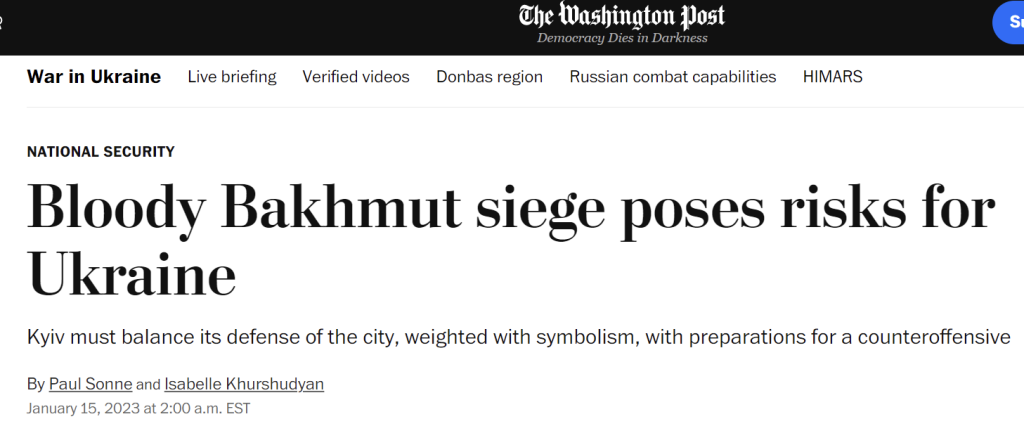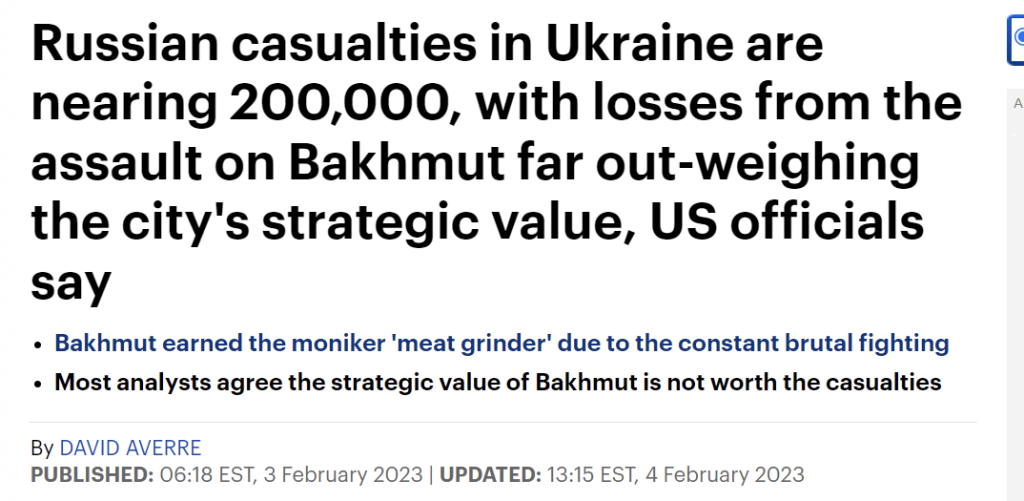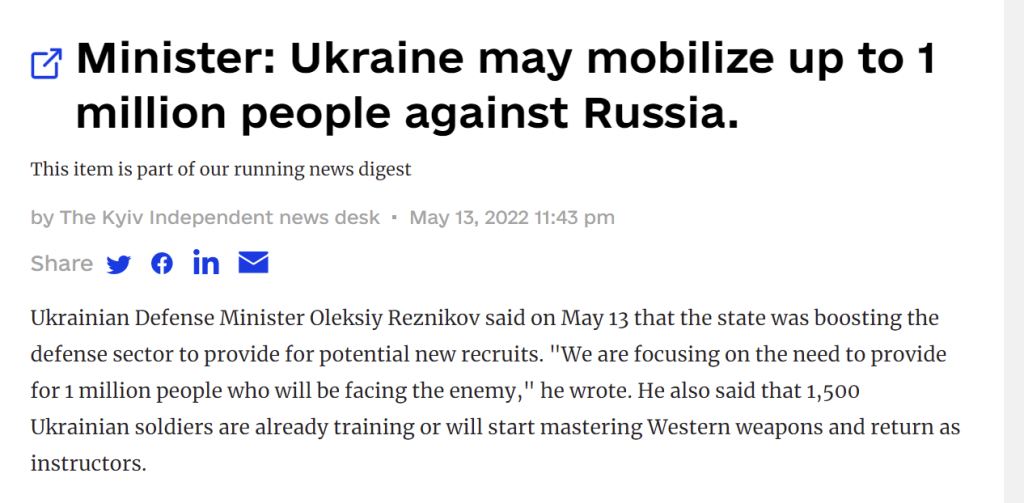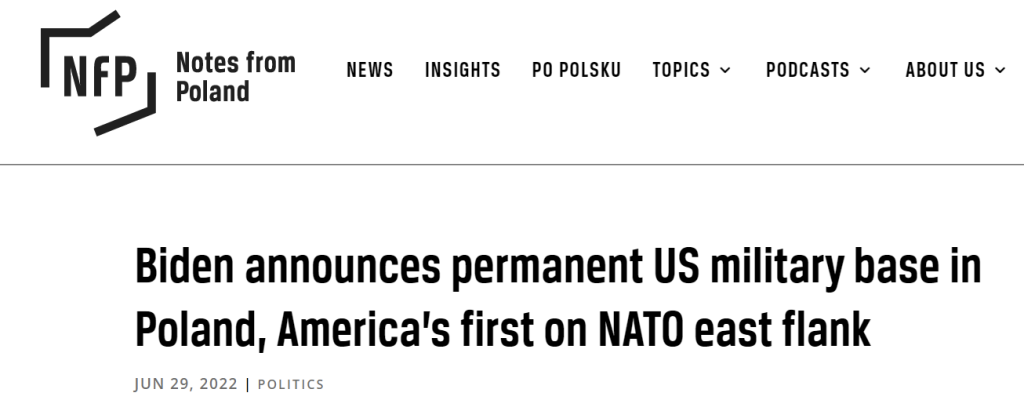Please Follow us on Gab, Minds, Telegram, Rumble, Gab TV, GETTR, Truth Social
On February 24, 2022, after months of troops amassing on Ukraine’s borders and failed peace talks, Russia invaded Ukraine. Russian’s military mobilized 150,000 troops in a “Special Military Operation” in Ukraine, the largest battle in Europe since World War 2. It has dominated media headlines for the last year. Almost a year later, we can look back and ask with some perspective, “Where do we stand”?. Who is winning this war? Who is losing? What are the objectives on each side? What’s the real narrative versus the mainstream media version?
The amount of media disinformation on this topic has reached completely surreal levels. When subject to a little scrutiny, the narrative being force-fed to the public completely falls apart. We will go through the facts on a number of fronts and show what’s actually happening. And we are going to dig in deeply on the real objectives on all sides- the US national security state’s reason to be involved, Russia’s goals, and Zelensky’s goal$$$. In later pieces, we will look more closely at the true theater of this conflict- it’s more of an economic than military one. Along with Russia’s partners China and Iran, it will eventually encompass several geographic hot spots.
The Initial Moves
The Russian advances the first few weeks of the war saw them sending units everywhere – to Kyiv, Kharkiv, and numerous points in the South. The divisions everywhere in Ukraine soon withdrew and turned home, and the fighting concentrated on the South, where most of the Ukraine military was concentrated.

Why did Russia do these moves initially, and later unwind them? Was this the plan, or a failure? We think that the initial moves were a combination of three factors. First, in 2014, Russia had attacked Ukraine to annex Crimea. Ukraine’s military folded in a week, and Russia soon annexed all of Crimea. Russia surely had this memory of a weak armed force that would quickly fold in mind. The beefed up, NATO supported forces of Ukraine surely took them by surprise.
Secondly, surely some of these broad initial moves was to spread Ukraine thin so they did not know where the real attack was coming from. As it turned out, the main conflict was focused on the Donbas and Luhansk, while the other areas were largely ignored.
Finally, it seems that Russia’s limited forces were partly designed to strike a blow against Ukraine, in an effort to get a strong immediate peace deal. Ukrainian leaders rejected a February, pre-invasion deal. Another one was worked out in April 2022, and then vetoed by the US and UK at the last minute. It appears Russia had a smart strategy in the beginning, but it was overruled by Western powers who think Russia can be defeated.
Who is Actually Winning?
Despite all the media narratives out there, we must make it very clear- Ukraine is losing this war - badly. In terms of territory, casualties, internal pressures, etc, Ukraine is on its back foot. And this is only after the initial ten months with 150,000-200,000 Russian troops in the field and limited bombardment. As Russia continues to put more soldiers into the country, and bring more force to bear on crucial infrastructure, the reality will become unavoidable.
The Institute for the Study of War has daily updates on the territory of the Ukraine war. It’s quite clear- Russia’s territory under control has greatly expanded since the start of the invasion. It has gained several provinces worth of territory and controls between 20-25% of Ukraine now. The blue territory around Kherson and Kharkiv seems not to be from Ukrainian military victories, but instead tactical withdrawals by Russia.

Despite the large Russian territorial advantage, the media and the Zelensky regime continue to push the narrative that the war won will be won in a few months. That is, a full capture of all that Russian territory by summer. Of course they just need massive amounts of NATO weapons and aid in order to guarantee the outcome ! [more on this grift in a future piece].


We all read about the massive numbers of NATO weapons and aid going to Ukraine. But probably more important is that NATO leadership and intelligence is almost completely running this war now. There has been no official pronouncement of this yet, but reading between the lines of the official narrative leaves no doubt. Take this recent statement from US former general and think tank member David Petraeus:

But there remain two flies in the ointment to the ‘Ukraine is winning’ narrative. The first is that this war has been fought largely at close distances, where Russia has an overwhelming advantage in artillery fire. It ranges from anywhere of 5:1 to 12:1 depending on the location and what source you read. This would account for a large part of Russia’s advantage in inflicting casualties. In addition, the West and Ukraine do not produce enough artillery rounds to support this rate long term. From the New York Times in October:
Last summer in the Donbas region, the Ukrainians were firing 6,000 to 7,000 artillery rounds each day, a senior NATO official said. The Russians were firing 40,000 to 50,000 rounds per day.
By comparison, the United States produces only 15,000 rounds each month.
The other challenge to the official narrative has been the recent fighting centered around Bakhmut (green circle) and Zaporozhia. The fighting has seen tremendous efforts by Ukraine, as it has decided to hold those locations at all costs. Recent information in the last week seems to indicate the Russians have encircled Bakhmut and are about to capture the city. Blogger Big Serge claimed that publicly available sources indicate the Ukranians committed thirty four brigades to Bakhmut- that’s between 110k-170k soldiers for one town. But as those units have come into artillery range and are slowly surrounded, it seems Ukraine is suffering heavy casualties across a host of units.
The fighting around Bakhmut looks like a desperate effort to hold the line, so much so that even regime outlet The Washington Post had to concede it was a risky endeavor:

German intelligence, as reported in Der Spiegel, estimated that the Ukrainians were losing 500-1000 soldiers per day in Bakhmut, which is a huge rate of attrition even considering the number of soldiers present. They also said it was a crucial point in the Ukrainian lines and likely to fall soon.
With the very likely capture of Bakhmut in February, and a withdrawal of Ukrainian troops to a new defensive line, the media will get more desperate. Or they will concoct a new narrative. But all it does is temporarily obfuscate the Russian military’s methodical progress, when we have been told forever that Ukraine is resisting well and can win this war in a matter of months.
Now on to the topic of total casualties. For obvious reasons, the official Ukrainian and Russian data should be ignored. But we should also entirely discount the mainstream media figures as propaganda as well. The New York Times and the Daily Mail cited US officials that the Russians have lost almost 200k dead after losses of “500 per day” in Bakhmut for several weeks. El Pais: reports “Between January 6 and 31, the Ukrainian High Command claims 17,000 Russian troops lost their lives in the battle, a figure that represents almost double the monthly average reported by Kyiv throughout 2022.”

First off, any of these outcomes are almost mathematically impossible. Russia initially deployed 150,000 troops into Ukraine. Even with rotations, that would mean that essentially 90% of more of troops deployed to the front lines had been killed or injured. Secondly, there is the practical element of their advance - the army continues to advance, gain territory, and not suffer mass surrenders, desertions, collapses of morale, or prisoners captured. We challenge you to name an army in history that suffered 80 or 90% casualty rates yet was also winning and holding new ground.
So what are the real casualty numbers for both Russia and Ukraine? We have three good estimates from credible sources.
The head of the European Commission, in a speech in November, let slip some distributing numbers from official sources. According to her sources, Ukrainian armed forces, after eight months of conflict, had suffered soldiers 100,000 KIA (Killed in Action). She later got a call that disclosing that the information was confidential, and it was scrubbed from the official speech on the website. If that was the number in November, we can extrapolate it’s 130,000-140,000 now.

At the beginning of her address, von der Leyen said that Russia's invasion of Ukraine brought death, devastation and untold suffering, and that it was estimated that "over 20,000 civilians and 100,000 Ukrainian soldiers have died in Ukraine to date."
However, later the text of von der Leyen's statement on the European Commission's website has been edited and published without data on casualties – neither among civilians nor among the military.
BBC estimated, with open source data, around 10,000 deaths in the first nine months of the war. Later in the article, they specify that: “BBC notes that, by the most conservative estimates, the real number of Russian soldiers killed in Ukraine may exceed 20,000, and the total number of irretrievable losses could be as high as 90,000.” Furthermore, the war has gone on for another two months- so let’s make that 20,000 now 40,000 or 50,000 to be safe on the Russian side.

Col. Douglas Macgregor has aggregated numbers and gets to a number of 122,000 KIA on the Ukraine side, with 30-35k presumed dead on top of that. He estimated 17k-22k dead on the Russian side and approximately twice that number wounded.
Putting this altogether, if we had to give final numbers, we would say the best guess is roughly 150,000 Ukrainians dead and 40-50,000 Russian soldiers dead. Russia has a three to one kill advantage thus far in the war. They will soon have an absolute numerical advantage in forces present in Ukraine. The math does not look good for Ukrainian casualties from here.
National Security State’s Objective with Russia
While it could take up its own article, the goal of the US national security state’s use of Ukraine have been obvious for years. Its goal is to have a long proxy war which weakens and eventually breaks Russia, and in the process, benefits US military suppliers and contractors.
NATO expansion towards Russia has been occurring since the 1990’s. Major thinkers like George Kenan and John Mearsheimer warned that this would lead to an authoritarian regime in Russia and an eventual war over Ukraine. Both were right. But they were ignored as the regime continued to push to surround and destabilize Russia.
The Rand Corp, a think tank joined at the hip with the Pentagon, in 2019 published an extensive piece on how to overextend and exhaust Russia. They examined a host of measures, including arming Ukraine, placing NATO forces in Ukraine and Europe, etc etc. Not coincidentally, most of these proposed measures became US policy in subsequent years.


The Atlantic Council, The Center for a New American Security (CNAS) and others all banged the drum about the dangers of Russian expansion and the importance of Ukraine. You can watch the Helsinki Commission’s recommendations to Congress this past summer to “Decolonize Russia” by splitting it up into multiple countries: https://www.csce.gov/international-impact/events/decolonizing-russia This plan has been around the since 1990’s – the fall of the USSR was not enough, Russia now has to be made a vassal state or a divided nation.
So clearly the US regime only views Ukraine as a way to expand NATO influence and destabilize Russia. Eventually, they would like to see Russia split up, either by regime change, bankruptcy, or an extension of ethnic conflicts like those in Ukraine.
The US cares little about the regime in Ukraine, little about the Ukrainian people, and has ignored Russia’s warnings on NATO and military expansion for two decades. This is a full-on play to take out of one of the two potential rivals in Eurasia. Unfortunately for the US, its strategy has backfired and has only pushed all of its Eurasian rivals closer together.
Russia’s Objectives
Russia’s aversion to NATO expansion and to long range missiles being in Ukraine and in range of Russian territory is well known. And also well understood, frankly. Most nations would understandably be wary if a strategic rival put ballistic missiles one hundred miles from your border. Would China countenance missiles on its border in Manchuria or Mongolia from the US or UK? Would Saudi Arabia tolerate Iranian missiles on its Yemeni border – actually, they did not and fought a war over it. Would the US tolerate Chinese missiles based in Monterrey or Juarez, Mexico ? They didn’t allow Soviet missiles in Cuba and caused a crisis over them.
Beyond that strategic concern, which seemed to have been addressed with the Minsk II accords in 2014, Russia added three more with the invasion of Ukraine. The first is the de-militarization of Ukraine. It’s now not enough for the regime of Ukraine to declare themselves neutral or not join NATO. They are too much of a threat having any military power, and have to see their military reduced to a bare defense force, similar to Japan after World War 2.
Secondly, Russia is pushing for what they called “the de-Nazification” of Ukraine. This is a complex topic, but suffice to say, that the last ten years has seen many far right and explicitly neo-Nazi leaders hold posts in the Parliament and government of Ukraine. In addition, there is a substantial presence of these people in the military, with a couple of whole battalions made up of SS-tattoo toting real Nazis. Google away for photo evidence! These people share the Nazi ideology of removing the ethnic Russians from their land to make way for more ‘living space’ for the ethnic Ukrainians. The Russians view this as a major reason for the atrocities in the Donbas, and only eliminating these elements from the regime can prevent further civilian losses.
Beyond that, the Russian government has now concluded that Zelensky is an unreliable negotiator. They think he is not acting in good faith and is a full-on NATO puppet. They have added that only a full regime change in Ukraine will be acceptable in order to protect all people of Ukraine, and to have lasting peace. If the Russians win, we may see Zelensky face trial or be executed for what Russia sees as his many crimes.
Russia has a larger agenda, in full strategic cooperation with China and Iran, that extends well beyond Ukraine. It also has just as much, if not more, of an economic dimension to it than a military one. We will cover that in a separate piece.
Is a Peace Deal Possible?
Before the war in early February 2022, there was a peace deal shepherded by President Macron of France. They agreed to largely the same terms as the Minsk II peace accords, with a few small modifications. The Russians said yes, but the Ukrainians rejected it, and the two countries went to war a week later.
In April, after multiple drafts with President Erdogan, the two sides appeared to have reached at least at a cease-fire. Then UK Prime Minister Boris Johnson urged Zelensky to turn it down and keep fighting.
Since then, the two countries have been at loggerheads. Ukraine will only agree to peace with full Russian withdrawals from occupied territory. The Russians have passed referendums and annexed those provinces. They view their return as a non-starter.
A third party, the US Administration, has been changing its tune of late. They have gone from 100% support of Zelensky’s stance to proposing a third way. Perhaps they see the upcoming Russian offensive. Perhaps they are losing faith in the Ukraine regime. Or perhaps they just have come to realize that Russia is not leaving the territory they currently occupy in Ukraine. But lately, both CIA Director Burns (also the former ambassador to Russia 2005-08) and Secretary of State Blinken have floated peace deals to the Russians that involve some recognition of the status quo. As of now the Russians have not agreed to anything. But at least the US is trying to have some sort of realistic discussion, unlike Ukraine.
The Next Stages
What’s going to happen next in this ugly conflict? Peace deals keep falling apart, and will continue to do so as long as the Zelensky regime is in power and(monetarily) incentivized to keep this going.
The Russian administration has mobilized and moved several hundred thousand troops into and around Ukraine. They are obviously massing troops for an offensive, and likely to pursue the weak points in the enemy lines with very high levels of forces. The forthcoming fall of Bakhmut and retreat to weaker lines by Ukraine will put them in a very poor position just as Russia is bringing far more offensive power to bear.

If 150k Russian troops have already have killed 150k Ukrainian troops, and with a three to one kill ratio….then what would a full Russian military deployment look like? How many casualties would 500k-700k troops be able to inflict? A similar 3:1 kill ratio would be a complete slaughter of Ukrainian forces. Ukraine only has a reservoir of about 1m men to be called up, and it’s already lost probably one quarter of them through death, surrender, and serious injuries. They will in late 2023 or 2024 have to either get massive external support, or throw in the towel.

So the big question is foreign involvement. Russia and Ukraine will continue to bulk up their forces, and Russia is likely to launch a major offensive against Ukraine’s weak points in the next month or so.
As of now, NATO forces have sent in a smattering of advisors and equipment. Poland sent a few thousand troops, Canada, and New Zealand as well. The US and UK have committed many troops to be ‘advisors’ and to operate heavy weapons systems, but claims they are not ‘directly fighting’. We find that hard to believe at this moment, but their numbers remain small relative to the number of Ukrainian troops.
Will we see a large official deployment of troops to the region by the US or NATO? Every elected leader has sworn up and down that it will not happen. But recently, former US general, head of the CIA, and think tank member David Petraeus floated a proposal:

The guts of the article go into a proposal for a multinational, US led force (not NATO), to intervene. That would act as a deterrence and a support force for Ukrainian military. The US has already moved some assets into place in the region to potentially fulfill this plan. It has increased its troop presence in Europe from 80,000 a year to 100,000 troops now.


The path near term looks clear: Russia will commit far more forces, and continue to inflict massive losses on Ukraine and capture more territory. Will that turn into a peace deal, or a full Ukrainian surrender in a year? Or will it turn into a wider war with US and / or full NATO participation? Looking into other aspects of this conflict, as we will do in subsequent pieces, should help to clarify the answer.
Email: [email protected]
Substack: decodingpolitics.substack.com
Medium: medium.com/@decodingpolitics
Twitter: twitter.com/DecodingPoliti2
Subscribe to our evening newsletter to stay informed during these challenging times!!
If you had doubts that the US national security state has an intense hatred of Russia and is fighting a proxy war.....then the news about the US blowing up Nordstream should be proof enough that that's the end goal.